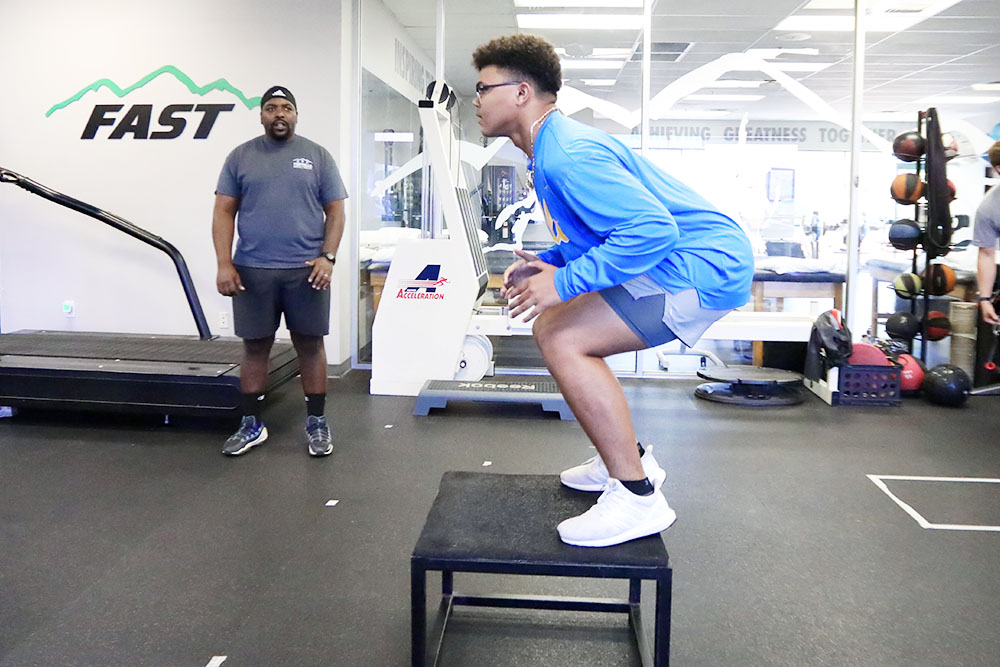Foothills’ FAST Performance Training has a long history of improving athletic function, ability, and sports performance. One of the most challenging elements of basketball to improve is the vertical. The vertical jump requires that you start with both feet on the ground, descend into a squatting position, and push yourself to a maximum height off the ground. This motion demonstrates the lower body explosiveness crucial to any sports performance, gathering power from the ground, through the legs, and releasing it through the body.
The advantages of improving a vertical include blocking shots, rebounding better, attacking harder, and ultimately dunking the ball better. Jump training can be as simple as heavy weight lifting for force production. Here are four keys to focus on that will help you reach new heights.
1. Technique
First, watch people you would like to emulate and practice their approach. Focus on jumping off one and two legs. Picture the jump in your mind and walk yourself through every step of their form. After you have a good idea of how you will approach the jump, it’s time to practice.
Start slowly going through the footwork and increase the speed and force you use as you gain comfort. Repetition is now the most important thing to focus on. With 1000 repetitions, the form, force used, and comfort will improve. This will be your basis for training, and achieving comfort with the form must be completed prior to moving on to the next steps.
2. Balance
Stability is crucial in vertical jump training. Without your ankle and foot being stable on the ground, you cannot accelerate into the air with maximal efficiency. Your ankle, foot, and hips all play a significant role in the stability of the jump to maximize hip, thigh, and calf use. Incorporate these single-leg balance exercises into your home workout:
- Jump landing in a single-leg squat.
- Jump landing into a single-leg squat on an unstable surface.
- Jump landing into a subsequent jump.
3. Jumping
This is the MOST important thing you can do. Practice, practice, practice! Practice stationary jumps, box jumps (with and without back steps), jumping to touch a marker overhead, lateral jumps, forward/backward jumps, and sequential jumps (2-5 consecutive). Coordination, muscle recruitment, overall force, and application are achieved with repetition.

4. Strength Training
Strength training is the last step in improving your vertical. With strengthening training, you must have good form. Training is nearly useless without proper form and increases your risk of injury. That said, strengthening will build on the neurological gains you achieved in the previous steps. This list of exercises is not all-inclusive, but these are the muscle groups you will need to focus on to increase your vertical. Add these exercises to your gym or home workout:
A. Squatting
- Back squats
- Front squats
- Butt-to-heel squats
B. Deadlifts
Deadlifts are a very good exercise for developing lower body and total body strength to improve your vertical. The best way to prevent injury performing deadlifts is to maintain a flat back. To do so, you should be squeezing your shoulder blades together, pushing your hips behind you with soft knees, and strongly bracing your core.
C. Weighted Jumps
- Band resisted
- Weight resisted
D. Single-Leg Squats
- Pistol squats
- Split squats
E. Glute/Ham Raises or Eccentric Hamstrings
F. Resisted Calf Raises
Many athletes would like to improve their game and athleticism to reach the level of competition they desire at the high school, college, and professional levels. Gaining in your vertical is a gratifying and fun achievement. Dunking a basketball was one of my first sports goals in life, and with a lot of hard work, I achieved this by my junior year of high school. I continued to enjoy doing it for years afterward while playing basketball. To all those striving to make gains in their vertical, best of luck and enjoy the gains!
If you need extra help determining a program geared toward increasing your vertical or if a nagging pain stops you from giving your all on the court, contact one of our Foothills clinics or FAST locations near you. We will help you get back in the game better than ever.






